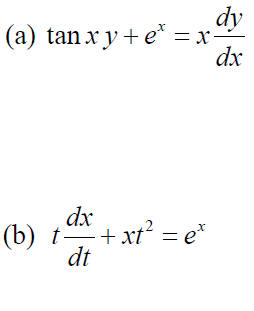|
Home |
Linear EquationsL4 Linear Equations (Section 2.3) Definition: A linear first order differential equation is an equation
Example:
Some Special Cases:
Discussion of the Method Involving an “Integrating Factor”: 1) Put the equation in the standard form:
where 2) Multiply both sides of the equation (4) by the integrating factor μ (x)
2) Determine μ (x) so that the left-hand side of the equation (5)
The general solution:
Method for Solving Linear Equations (a) Write the equation in standard form
(b) Calculate the integrating factor μ (x) by the formula
(c) Give the general solution
where C is an arbitrary constant. Example: Find the general solution to the equation
Example: Solve the initial value problem and find the value of y (−1).
Example: A rock contains two radioactive isotopes, RA1 and RA2 , [rate of change]= [rate of creation] – [rate of decay]
If k = 4 / sec and y (0) = 30 kg, find the mass y(t ) of RA2 for t ≥ 0 Existence and Uniqueness of Solution for a Linear
First-order Theorem 1. Suppose P(x) and Q(x) are continuous on
the
In fact, the solution is
for a suitable value of C. (See problem 34 for the details on the proof) Special Cases when the Definite Integral is Used Example: Solve the initial value problem
Example: Solve the initial value problem
|




















